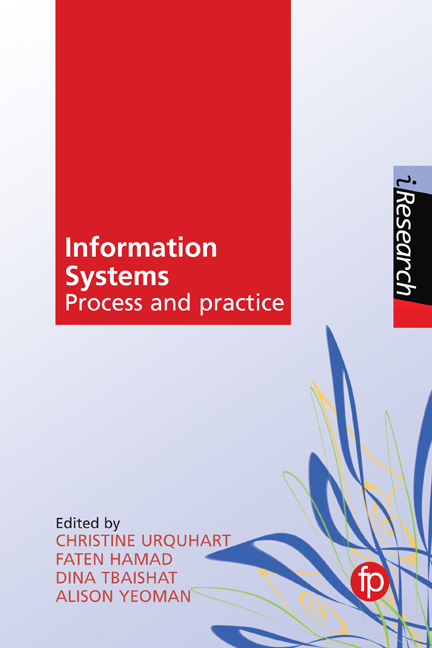Book contents
- Frontmatter
- Contents
- List of tables and figures
- Series editor's foreword
- About the authors
- 1 Introduction
- 2 Approaches to information architecture
- 3 Taxonomy testing for information architecture
- 4 The enterprise website and its information structures
- 5 Analysing activities, roles and processes
- 6 Libraries and the organisation of library processes – a history of operational research, and the use of process modelling
- 7 Using Riva process modelling to study book acquisition in academic libraries
- 8 Workflow analysis and process mapping in US academic libraries
- 9 A theoretical framework for designing and evaluating semi-structured document triage interfaces
- 10 Resource discovery case studies
- 11 Increasing social connection through a community-of-practice-inspired design
- 12 Methods for studying information provision, networking and communication in patient support groups
- 13 Health information systems: clinical data capture and document architecture
- 14 Producing systematic reviews and getting evidence to the clinician
- Index
12 - Methods for studying information provision, networking and communication in patient support groups
Published online by Cambridge University Press: 08 June 2018
- Frontmatter
- Contents
- List of tables and figures
- Series editor's foreword
- About the authors
- 1 Introduction
- 2 Approaches to information architecture
- 3 Taxonomy testing for information architecture
- 4 The enterprise website and its information structures
- 5 Analysing activities, roles and processes
- 6 Libraries and the organisation of library processes – a history of operational research, and the use of process modelling
- 7 Using Riva process modelling to study book acquisition in academic libraries
- 8 Workflow analysis and process mapping in US academic libraries
- 9 A theoretical framework for designing and evaluating semi-structured document triage interfaces
- 10 Resource discovery case studies
- 11 Increasing social connection through a community-of-practice-inspired design
- 12 Methods for studying information provision, networking and communication in patient support groups
- 13 Health information systems: clinical data capture and document architecture
- 14 Producing systematic reviews and getting evidence to the clinician
- Index
Summary
COMMENTARY: CHRISTINE URQUHART
In the evaluation of the patient support portal, Cristina Vasilica and Paula Ormandy used activity theory, which was originally proposed by Russian psychologist Alexey Leontiev, and is rooted in early 20th century Russian psychology. There are two main ideas: the social nature of the human mind, and the inseparability of human mind and activity, the former idea elaborated by Vygotsky, and the latter by Rubinshtein (Clemmensen, Kaptelinin and Nardi, 2016). Vygotsky's theories of learning emphasise the social far more than those of Piaget, and Vygotsky's ideas about scaffolding, social interactions and learner support are used in the design of distance learning platforms and virtual learning environments (e.g. Boettcher, 2004; Huang, Rauch and Liaw, 2010). The version of activity theory commonly presented is based on the work of Engeström and team (Engeström, Miettinen and Punamäki, 1999), which added the notion of community to the subject–object interaction. An activity is seen as a system of human ‘doing’ in which a subject works on an object in order to obtain a desired outcome. To do this, the subject employs tools, which may be external to the subject, or internal. The common representation of activity theory shows one inner triangle with apices for subject, object and community, and an outer triangle that has apices for the mediating tools. Between subject and object, the mediating artefacts are tools (as mentioned), between community and object there is a division of labour (to allow distribution of activity), and between subject and community there are rules.
For example, in a study that used activity theory to examine web application requirements, the tools included the internet, books and methodologies; the rules included trading standards and policies; and the division of labour included roles such as the warehouse despatcher and the web developer (Uden, Valderas and Pastor, 2008). The subject was the customer; the object was the product to be purchased; and the community included managers, customers and software companies. Pretty straightforward, seemingly, but the value of using activity theory to frame the later analysis of activities into actions and operations, and hence the task model, is that the interactions between people, their tools and resources are described (unlike most examples of hierarchical task analysis).
- Type
- Chapter
- Information
- Information SystemsProcess and Practice, pp. 205 - 232Publisher: FacetPrint publication year: 2017
- 1
- Cited by



